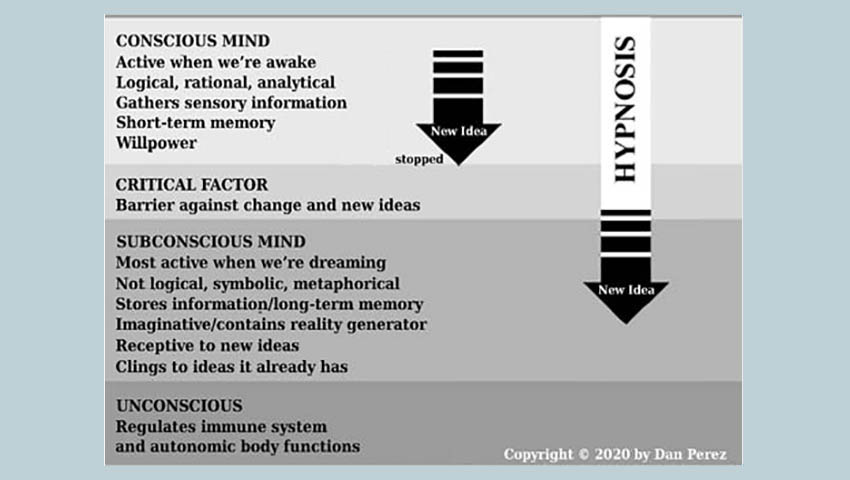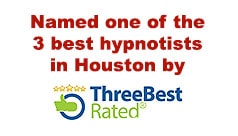In just a few words, hypnosis is a state of increased physical relaxation, focused awareness and increased suggestibility.
According to influential hypnotist Dave Elman, hypnosis is defined as “a state of mind in which the critical factor is bypassed and selective thinking is established.”
So how does this work? The way I like to explain it is to think of the mind as having several layers, one above the other. The layer above is the conscious mind. It’s highly logical, and it gathers and analyzes information. The conscious mind is where our willpower resides. Unfortunately, changing habits by pure willpower alone can sometimes be difficult. (click on chart image at right)
The layer below is the subconscious mind–a very interesting place indeed, at its most prominent when you are dreaming at night, but it’s still active during the day, like a computer program running in the background. The subconscious is much less logical, which is one reason dreams don’t seem to make sense sometimes. The subconscious sorts and stores vast amounts of information, forming our long-term memory and performs behind-the-scenes work like memory recall and problem solving. The subconscious is also thought to contain what brain scientists refer to as the reality generator, which creates the reality we perceive and feel around us.
Beneath the subconscious is the unconscious, which regulates our immune system and automatic body functions like heartbeat, breathing and blinking. Dividing the conscious and subconscious is a boundary called the critical factor, and this boundary serves as sort of a guardian or gatekeeper to prevent potentially dangerous ideas from penetrating the subconscious, which is very suggestible. The critical factor and the conscious mind work in tandem to critically evaluate thoughts and experiences from your daily life and make short-term decisions.
Unfortunately, the critical factor can do its job too well sometimes and prevent good ideas (like “I want to stop smoking” or “I want to lose weight”) from reaching the subconscious as well.
Hypnotism distracts the conscious mind and bypasses the critical factor, allowing positive suggestions to go directly into the subconscious, which is very receptive. This is the “selective thinking” Elman referred to.
Then, when the hypnotized person emerges from the hypnotic state (also known as trance), the suggestions manifest themselves in his or her conscious behavior.
I really like the definition hypnotist Anthony Jacquin coined: “Hypnosis is the art of presenting ideas directly to the receptive subconscious mind.”
This has been a simplified explanation of a complicated process, but hopefully you have a better idea of how it works. For more information, click on the FAQ button on the top lefthand menu.
TAKE ACTION NOW! CLICK "CONTACT DAN" AT UPPER LEFT
OR CALL TOLL-FREE 800-481-5949 FOR A FREE CONSULTATION.












